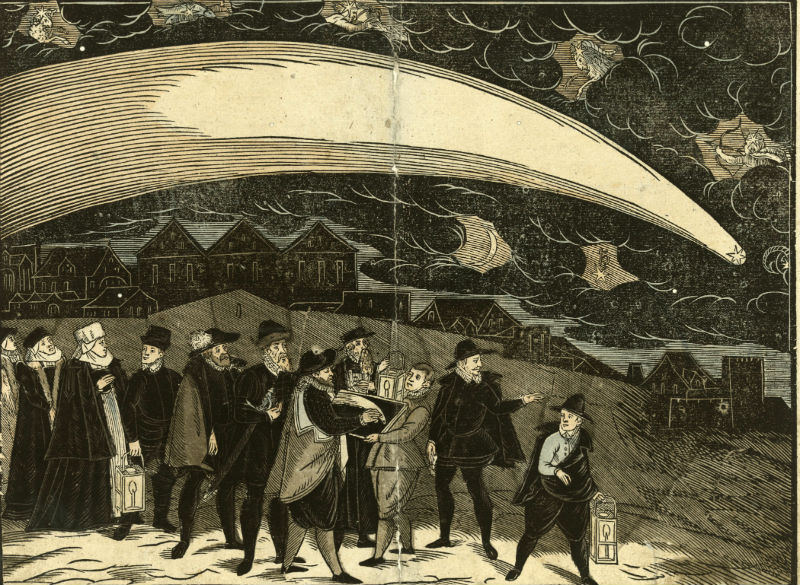 The great comet of 1577
The great comet of 1577
Exciting as it is (and it is incredibly exciting), the Rosetta mission is the latest in a history of comet exploration that has added to our knowledge of these icy dirtballs.
Comets are usually just a few kilometres across and consist of a mixture of ice, carbon-based material and rock dust. A comet can develop a spectacular million kilometre-long tail of gas and dust when its elongated orbit brings it close to the sun.
The warmth of the sun vaporises water, carbon monoxide and other volatile substances that are otherwise held as ice. Jets of gas escape from the solid part of the comet (its nucleus) to feed the growing tail. However, for most of the time a comet is far from the sun, and it is simply a dark, dusty object too faint to detect using even the largest telescopes.
It is hoped that access to a comet will provide a pristine, deep-frozen sample of the material from which the planets were built. Comets have been hitting the Earth since the Earth was formed. We currently do not know what fraction of Earth’s ocean water was delivered to the surface by comets after the Earth was formed, as opposed to water which escaped from inside and condensed on the early Earth.
Comets also carry organic molecules – and one theory has it that these building blocks for life on Earth were delivered by comets rather than forming here. Recent observations by the ALMA telescope in Chile revealed very simple organic molecules – two sorts of hydrogen cyanide and also formaldehyde – being made in comets today.
Missions to comets
Small wonder, then, that comets have been the targets of several space missions. To date, eight comets have been visited over the course of ten successful missions. In 1982, a probe called ISEE-3, which had already been in space for four years, was renamed International Cometary Explorer (ICE) and re-tasked to fly past comet Giacobini-Zinner, at a minimum distance of 7,862km. The probe had no cameras on board, but other sensors gathered data on the interplay between the solar wind and the comet’s atmosphere. ICE subsequently joined a fleet of two Soviet, two Japanese and one European Space Agency probe that studied Halley’s comet in 1986. ESA’s mission, Giotto, was the best equipped. It got to within nearly 600km, and sent back the first close-up pictures of a comet’s nucleus.
The most spectacular mission before Rosetta was NASA’s Deep Impact, which in 2005 dropped an impactor into the nucleus of comet Tempel 1, while the mother-ship watched. The impact excavated more dust and less ice than had been expected. Another surprise was that much of this material was clays and carbonates, which usually require liquid water for their formation.
Only one mission has brought back samples from a comet. This was NASA’s Stardust, which in 2003 collected dust that was escaping from comet Wild 2. The sample return capsule made it back in 2006 and included grains that seemed to have formed at high temperatures in the inner solar system before heading out to the cold comet-forming region, as well as traces of an amino acid – glycine – adding weight to the idea that comets could be source of the building blocks of life. Remarkably, the Stardust mother-ship was redirected to Tempel 1, the only comet to have been visited on two different occasions. In 2011 sent back pictures of the crater that had been made by Deep Impact’s impactor.
Rosetta images
It is early days for Rosetta, and the team have yet to release more than a few images and other data from the main instruments. However navigation camera images reveal a startling landscape in far greater detail than has previously been achieved. There are boulders up to several metres in size, patchily distributed across the surface.
![]() Are they pure ice? Dust cemented by ice? Will the apparently smooth areas turn out to be just as rugged on a smaller scale when the Philae lander gets close enough to see finer detail? What are the exposed layers that can be seen in some areas, and how did they form? And how is all this compatible with the extremely low-bulk density of the comet, which Rosetta’s orbit and shape-mapping have revealed to be only about 40% the density of solid ice? The interior must be porous, but there’s precious little sign of that at the surface.
Are they pure ice? Dust cemented by ice? Will the apparently smooth areas turn out to be just as rugged on a smaller scale when the Philae lander gets close enough to see finer detail? What are the exposed layers that can be seen in some areas, and how did they form? And how is all this compatible with the extremely low-bulk density of the comet, which Rosetta’s orbit and shape-mapping have revealed to be only about 40% the density of solid ice? The interior must be porous, but there’s precious little sign of that at the surface.
This article was originally published on The Conversation. Read the original article.



Rate and Review
Rate this article
Review this article
Log into OpenLearn to leave reviews and join in the conversation.
Article reviews